 Image search results - "soto" Image search results - "soto" |

Senryuji Temple, Sanmon Gate, which is the front gate. Reconstructed in 1859, and renovated in 2006-2007. The temple was founded by a monk named Roben 良弁 in 765. 山門
|
|

View after passing through the Sanmon Gate. Bell Tower ahead.
|
|

Bell Tower, reconstructed in 1844. It stands between the Sanmon Gate and Hondo main hall.
|
|

Bell Tower
|
|

Hondo main hall. 本堂
|
|

Hondo main hall. 本堂
|
|

Carved stone lantern in front of Hondo
|
|

Carved stone lantern
|
|

View from Hondo hall
|
|
|
|

The cherry blossoms lining Sotobori Moat also look stunning from the road, Sotobori-dori in front of Kagurazaka.
|
|

Jizo statues
|
|

People in a long line waiting to enter Canal Cafe to either dine or rent a rowboat.
|
|

Entrance to the Benzaiten Pond Greenery Preservation Area. Adjacent to Senryuji Temple, it used to be part of the temple grounds. The small loghouse is an activity space. 狛江弁財天池緑地保全地区
|
|

Canal Cafe is right below the cherries. But notice empty tables despite the long line.
|
|

The area is well forested and maintained by volunteers. The area is open to the public only on certain days.
|
|

Empty rowboats too.
|
|

Cherry trees along the Sotobori Moat. Formerly a moat of Edo Castle, this canal stretching from Iidabashi Station to Ichigaya Station along the Chuo Line.
|
|
|

This greenery area features a variety of flora and fauna, insects, and birds such as the kingfisher.
|
|
|
|
|

Bamboo grove
|
|

Rowboats and low-hanging cherries.
|
|

Benzaiten Goddess
|
|

The end of the moat is also a good viewpoint.
|
|

The area includes two ponds. Here's one called Hyotan Pond. ひょうたん池
|
|

The end of the moat is also a good viewpoint.
|
|

The other pond is Benzaiten Pond. The natural spring feeding water to the pond once dried up. In recent years, efforts were made to supply water to the pond. A deep well was dug to feed water to the pond which has koi carp. 霊泉(弁財天池)
|
|

How it looks from the end of the moat.
|
|

Benzaiten Shrine next to the pond.
|
|

How it looks from the end of the moat.
|
|
|

The moat is parallel to the Chuo Line. View from Shin-Mitsuke Bridge. 新見附橋
|
|

Sobu Line passes through.
|
|

Sobu Line passes through.
|
|

Chuo Line passes through. 中央線
|
|
|

Photographers who love trains and cherries flock here.
|
|
|

Canal Cafe
|
|

Sotobori Park on the other side of the moat. 外濠公園
|
|

Path to front gate of Gotokuji Temple known as the Ii Clan's family temple. Over 300 lords (incuding 6 Hikone Castle lords), wives, concubines, and children related to the Ii Clan from Hikone Castle in Shiga Prefecture, are buried here.
|
|
|

Path to front gate of Gotokuji Temple.
|
|

Somon front gate of Gotokuji Temple.
|
|

Somon front gate of Gotokuji Temple in Setagaya, Tokyo. On the left corner is a historic site stone marker for Ii Naosuke's gravesite. 豪徳寺
|
|

Historic site marker for Ii Naosuke's gravesite. Gotokuji Temple is known as the Ii Clan's family temple. Over 300 lords, wives, concubines, and children related to the Ii Clan, from Hikone Castle in Shiga Prefecture, are buried here.
|
|

After going through the Somon front gate, we see the pagoda and the Butsuden Buddha Hall straight ahead.
|
|
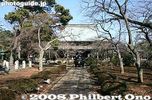
Butsuden Buddha Hall straight ahead.
|
|

Incense burner and Butsuden Buddha Hall.
|
|

Butsuden Buddha Hall, Gotokuji temple, Setagaya, Tokyo. This was renovated by Lord Ii Naotaka's wife and oldest daughter. 仏殿
|
|

Roof ridge of Butsuden includes the family crest for the Ii Clan. Gotokuji temple.
|
|

Butsuden Buddha Hall
|
|

Inside Butsuden Buddha Hall 仏殿
|
|
|

Butsuden Buddha Hall side view.
|
|

Butsuden Buddha Hall and the Hondo main worship hall behind on the right.
|
|

Gotokuji temple's Hondo Main Hall 本堂
|
|

Gotokuji temple's Hondo Main Hall, Setagaya, Tokyo. Ii clan's family temple. 本堂
|
|

Hondo Main Hall
|
|

Inside Hondo Main Hall
|
|

Ii clan crest on rain water barrel under the roof of Gotokuji temple Hondo Hall, Setagaya, Tokyo.
|
|

Hondo Main Hall
|
|

View from Hondo Main Hall
|
|

Bell tower
|
|
|
|

Three-story pagoda
|
|

Three-story pagoda, recently built.
|
|
|
|
|
|

Temple office sells souvenirs such as the maneki neko beckoning cat in various sizes (and prices).
|
|

Temple office sells maneki neko beckoning cat in various sizes (and prices).
|
|

Path to the temple cemetery where the Ii clan is buried.
|
|

Gate to Maneki Neko Beckoning Cat Temple. There are a few theories (or legends) as to how the maneki neko (Beckoning Cat) was created. One theory comes from this temple.
|
|

Maneki Neko Beckoning Cat Temple is a small worship hall dedicated to the beckoning cat. On the left of the temple, notice a little roofed shelf. 猫観音を祀る招猫殿
|
|

Inside Beckoning Cat Temple. The altar's objects of worship are numerous beckoning cat dolls.
|
|

One day, Lord Ii Naotaka was doing falconry and was on his way home when it started to rain. He sought shelter under a tree at the temple. Then he saw a cat raising its paw...He went to the cat and then lightning struck the tree he was standing under. In appreciation, Naotaka gave donations to the temple.
|
|

On the left of the Beckoning Cat Temple is a shelf where you can offer your lucky cat after it has brought you good luck.
|
|

Shelf for beckoning cats, maneki neko at Gotokuji temple in Setagaya, Tokyo.
|
|

Shelf for beckoning cats, maneki neko. Gotokuji temple, Setagaya, Tokyo.
|
|

Beckoning cats, maneki neko, which did their duty for their owners who now offer them to the temple as a gesture of thanks. Gotokuji temple, Tokyo.
|
|

Gotokuji temple votive tablet. This cat connection with Ii Naotaka gave rise to Hiko-nyan, the official mascot of Hikone, Shiga Prefecture.
|
|

Way to cemetery. Six Hikone Castle lords, including Ii Naosuke, have graves here. Setagaya was the domain of the Ii clan who often worked in the Tokugawa government.
|
|

Straight ahead is the grave of Lord Ii Naotaka, the 2nd lord of Hikone Castle in Shiga Prefecture.
|
|

Turn left and you see this. Ii clan graves on both sides. Lord Ii Naosuke's grave is at the very end on the left.
|
|

Lord Ii Naosuke's grave is at the very end on the left.
|
|

Grave of Lord Ii Naosuke (1815-1860), the lord of Hikone Castle in Shiga Prefecture and Chief Minister of the Tokugawa Shogun's government. Gotokuji temple, Setagaya-ku, Tokyo. 井伊直弼の墓 豪徳寺
|
|

Only Ii Naosuke's grave has a sign explaining about him.
|
|

Grave of Lord Ii Naosuke (1815-1860), the lord of Hikone Castle in Shiga Prefecture and Chief Minister of the Tokugawa Shogun's government. Gotokuji temple, Setagaya-ku, Tokyo. 井伊直弼の墓 豪徳寺
|
|

Gravestone of Ii Naosuke.
|
|

Right side of Lord Ii Naosuke's grave.
|
|

Tree of white camellias grow about Lord Ii Naosuke's grave.
|
|

Grave of Lord Ii Naosuke's wife.
|
|
|

Grave of Lord Ii Naohide (1755-1789). He served as Tairo Chief Minister in the Tokugawa government. Gotokuji temple, Setagaya, Tokyo 井伊直幸
|
|

Grave of Lord Ii Naotaka's eldest daughter who donated a lot to the temple. 井伊直孝長女
|
|
|
|

Grave of Lord Ii Naotaka (1590-1659), 2nd lord of Hikone, Shiga. Gotokuji temple, Setagaya, Tokyo 井伊直孝
|
|

Grave of Lord Ii Naoyoshi (1727-1754), Gotokuji temple, Setagaya, Tokyo 井伊直禔
|
|

Grave of Lord Ii Naotsune (1693-1710), Gotokuji temple, Setagaya, Tokyo 井伊直恒
|
|

Grave of Lord Ii Naonori on right.
|
|

Grave of Lord Ii Naonori (1848-1904), Gotokuji temple, Setagaya, Tokyo 井伊直憲の墓
|
|

Six Jizo
|
|

Higashimon East Gate (closed)
|
|

Ii family crest on East Gate
|
|

The temple is surrounded by a wall with barbed wire.
|
|
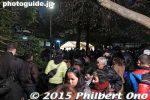
On New Year's Eve, Gotokuji temple allows people to ring the temple bell to ring out the old year in a ceremony called Joya-no-kane.
|
|
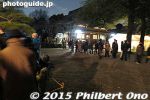
The line of people got longer and longer as midnight approached.
|
|
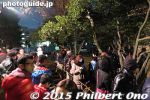
Quite a few people braved the cold to ring the temple bell on New Year's Eve on Dec. 31, 2014.
|
|
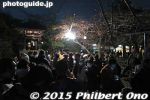
Temple bell in sight. Had to wait about an hour.
|
|
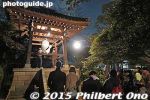
Gotokuji's temple bell on New Year's Eve.
|
|

Ringing Gotokuji's temple bell on New Year's Eve.
|
|
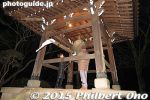
Each person got to ring the bell only once.
|
|
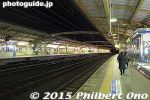
Gotokuji Station on early New Year's morning.
|
|
|
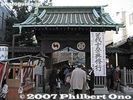
First built by Tokugawa Ieyasu in 1612, Sengakuji temple belongs to the Zen Soto sect. This is the Chumon Gate, facing the south, the first gate most people pass through to enter Sengakuji temple. Reconstructed in 1836. 中門
|
|

After the Chumon is the Sanmon Gate which is the temple's main gate. Reconstructed in 1832. 山門
|
|
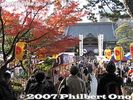
Path to the Hondo temple hall. 本堂
|
|
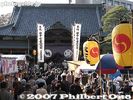
Hondo temple hall. The original hall was destroyed during World War II. Reconstructed in 1953 in the Kamakura style. 本堂
|
|
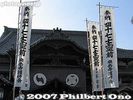
Since it was during the Gishisai Festival on Dec. 14, banners are in front of the Hondo hall for the 47 loyal retainers of Ako. Read about it here.
|
|
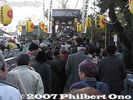
During the Gishisai Festival in mid-Dec., the temple is especially crowded. This is the long line to enter the graves of the 47 loyal samurai retainers. The gravesite's gate up ahead was the back gate of the Ako estate in Tokyo. Later moved here.
|
|
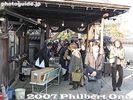
At the gate to enter the graves of the 47 ronin, they sell incense sticks. 四十七士墓所の門
|
|
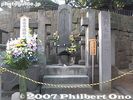
Grave of Lord Asano Naganori (Takumi-no-kami) (1667-1701) of Ako Province.
|
|

Asano clan grave
|
|
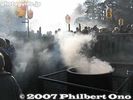
Incense burner
|
|

Large way going to the graves of the 47 ronin masterless samurai at Sengakuji temple. 四十七士墓所
|
|
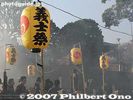
Gishisai lanterns.
|
|

The graves all have headstones with the loyal retainer's name on it and age at death.
|
|

People buy incense sticks at the gravesite gate and place incense at all the graves.
|
|
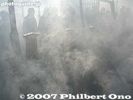
On the Gishisai day or anniversary of the attack on Kira, there is an extra amount of people and incense smoke.
|
|

The smoke can kill all the bugs in your fur or wool coat.
|
|

Very thick smoke, but not suffocating. People with asthma or lung problems might want to avoid this.
|
|
|
|
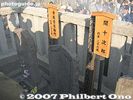
Names are clearly written on wooden plaques.
|
|

Oishi Kuranosuke's grave
|
|

Soon after the 47 retainers committed seppuku on Feb. 4, 1703, they were buried here.
|
|
|
|

The gravestones all look alike. There is a map showing who is buried where.
|
|
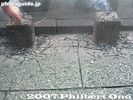
Worshippers pile on the incense
|
|
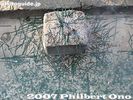
Pile of incense in front of a grave.
|
|

Statue of Oishi Kuranosuke, leader of the 47 loyal retainers. He's looking (glaring) east toward Edo. The temple grounds also have the Ako Samurai Memorial Hall and the well where they washed Kira's head.
|
|

The Gishisai on Dec. 14 marks the day when the 47 loyal retainers attacked and beheaded Kira to avenge their master (Lord Asano) in 1702. They then marched to Sengakuji to present the head to their master's grave. This is reenacted annually.
|
|
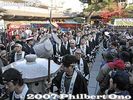
Gishisai on Dec. 14: Headed by Oishi Kuranosuke, the 47 loyal retainers arrive Sengakuji temple.
|
|
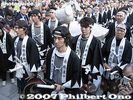
Gishisai: Kira's head strung on a spear is brought to Sengakuji temple.
|
|
|
|

Leader of the 47 ronin, Oishi Kuranosuke goes in front of the Hondo hall and reported their successful capture of Kira.
|
|
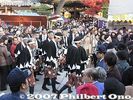
The 47 masterless samurai then proceed to the nearby grave of their Lord Asano.
|
|
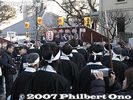
Heading to their lord's grave.
|
|

After reporting to their lord, the group leaves the temple.
|
|
|
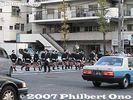
They cross the street full of cars. A Gishisai Festival is also held in Ako in Hyogo Prefecture.
|
|
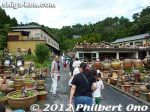
Shigaraki has a good number of pottery centers and Sotoen (宗陶苑) is major one. I visited for the first time in Aug. 2012. It covers a large ceramic park-like area.
|
|
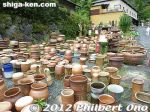
Sotoen has a very large number of Shigaraki pottery pieces outside in park-like tract. All for sale. Shigaraki ware is known for its weather-resistance, so they are suited for gardens and outdoor use.
|
|

Racks and racks of Shigaraki tanuki or racoon dogs.
|
|
|
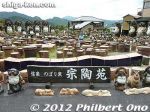
Photo op at Sotoen. They got almost everything you can imagine. The giant tanuki is priced as much as 700,000 yen.
|
|

Overview of the heart of Sotoen.
|
|
|
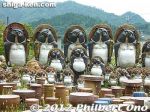
Tanuki for sale at Sotoen, Shigaraki.
|
|
|
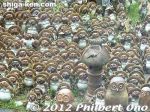
Smaller tanuki cost a few thousand yen.
|
|

They also have owls. This one has a camera.
|
|
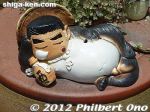
Crayon no Shinchan.
|
|
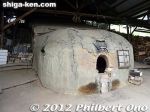
Sotoen's main attraction is this noborigama or sloping kiln. Japan's oldest noborigama. The bottom chamber is the furnace where they burn wood. 登り窯
|
|

Sotoen's noborigama kiln is 15 meters wide, 30 meters long, and 3.5 meters high. It has eleven chambers going up a slope. 登り窯
|
|
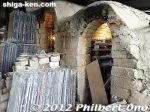
The heat from the furnace at the bottom chamber rises and seeps into all the chambers. 登り窯
|
|
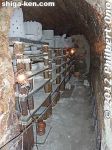
A noborigama chamber. The chambers get larger toward the top of the noborigama kiln. 登り窯
|
|
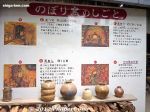
"Noborigama" kiln explanation in Japanese. It takes 40-50 days to fill the kiln, and 7-10 days to fire. 登り窯
|
|
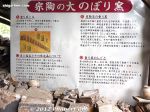
"Noborigama" kiln explanation in Japanese
|
|

The top of the noborigama kiln.
|
|

Steps along the side of the noborigama kiln.
|
|
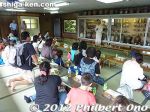
A talk about Shigaraki ware at Sotoen.
|
|
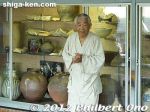
A talk about Shigaraki ware at Sotoen.
|
|
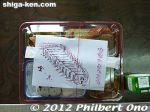
Bento lunch at Sotoen.
|
|
|
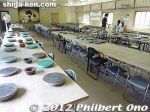
Another highlight of Sotoen was a pottery lesson for beginners. They have a huge pottery classroom.
|
|

First, an instructor demonstrated the basics of pottery making with a block of clay. Easy enough for anyone to make a simple bowl or cup.
|
|

The instructor showed how to smooth the top edge with a wet cloth.
|
|

Here's our block of Shigaraki clay.
|
|
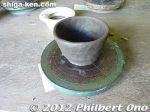
After maybe 20-30 min., my little bowl.
|
|
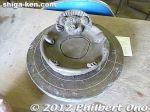
Another person got more creative. We were going to see the result in Sept.
|
|

Sotoen gift shop.
|
|
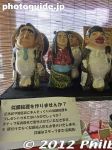
They even can make Shigaraki figurines based your likeness if you give them photos of your face.
|
|
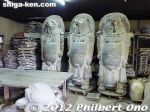
Large tanuki.
|
|
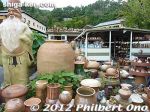
Pottery everywhere at Sotoen.
|
|
|
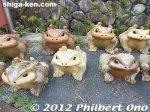
Frogs are another auspicious pottery piece. Sotoen Web site: shigarakiyaki.co.jp
|
|
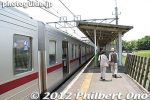
Morinji is a Soto-Zen temple famous for the Bunbuku Chagama (分福茶釜) folk tale about a tanuki raccoon dog that transformed into a steel pot used by the temple priest. Near Morinji-mae Station on the Tobu Line. One stop before Tatebayashi Station.
|
|

Morinji-mae Station. Morinji temple is a short walk away (660 meters).
|
|
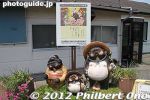
A symbol of Tatebayashi, Tanuki raccoon dogs welcome you in front of Morinji-mae Station. A hint of what's in store. A story panel starts to explain the tanuki story. Other story panels are found on the way to the temple.
|
|

The first panel explaining the famous Bunbuku Chagama (分福茶釜) folktale about a tanuki raccoon dog which turned into a tea pot. Morinji temple is where the folktale originated. There are multiple versions of the story.
|
|
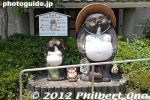
Even at the Morinji temple parking lot, tanuki statues.
|
|
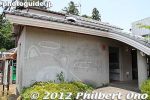
Women's restroom at the Morinji parking lot has a tanuki design.
|
|
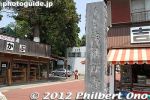
The way to Morinji temple is lined with some tourist souvenir shops.
|
|
|
|
|
|
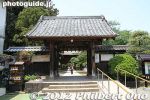
First you see this Somon Gate (総門), built in 1468 and normally called Kuromon Gate (黒門), to enter Morinji temple, one of Tatebayashi's main tourist sights.
|
|

Map of Morinji temple. Morinji was founded by the priest Dairin Shotsu (大林正通), During a pilgrimage, Shotsu met an old priest Shukaku-osho at the foot of Ikaho in Gunma.
|
|

In 1426, Shotsu took Shukaku with him to Tatebayashi and built a tiny temple. In 1468, the local Aoyagi Castle lord Akai Masamitsu (赤井正光) indebted to Shotsu, donated some of his land for the temple.The 13th panel explaining the famous Bunbuku Chagama folktale.
|
|

The Sando path (参道) from Somon Gate to Sanmon Gate (山門) is lined with 21 tanuki statues on both sides. The temple really plays up on its Bunbuku Chagama folktale fame.
|
|
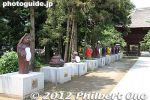
Tanuki statues on the left side of the Sando path to the Sanmon Gate.
|
|
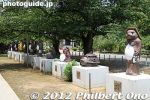
Tanuki statues on the right side of the Sando path to the Sanmon Gate.
|
|
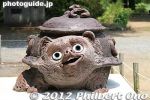
A few statues shows a tanuki morphed into a steel tea pot at Morinji temple, Tatebayashi, Gunma Prefecture. Based on the Bunbuku Chagama folktale.
|
|
|
|
|
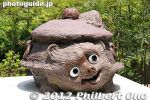
Another tanuki morphed into a steel tea pot at Morinji temple, Tatebayashi, Gunma Prefecture. Based on the Bunbuku Chagama folktale.
|
|
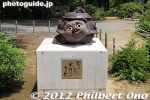
In folklore, tanuki is a mischievous shapeshifter so it is often depicted in many different costumes.
|
|
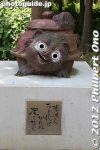
Tanuki morphed into a steel tea pot at Morinji temple, Tatebayashi, Gunma Prefecture.
|
|
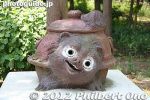
Tanuki morphed into a steel tea pot at Morinji temple, Tatebayashi, Gunma Prefecture.
|
|
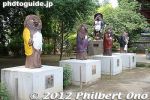
The statues recently got painted. Before, they were just bare stone statues.
|
|
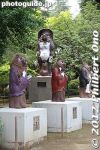
Most of these tanuki came from Shigaraki in Shiga Prefecture. Shigaraki is one of Japan's most famous pottery centers.
|
|
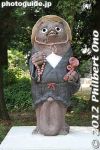
Tanuki raccoon dog statue at Morinji temple at Tatebayashi, Gunma Prefecture.
|
|
|
|
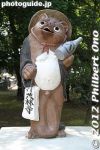
Shigaraki tanuki is said to bear Eight Lucky Omens (八相縁起). 1. The hat is protection from unexpected disasters...Shigaraki tanuki is said to bear Eight Lucky Omens (八相縁起). 1. The hat is protection from unexpected disasters. 2. The smiling face is for affability, 3. The large eyes is for seeing the situation and making correct and considerate decisions, 4. The large belly is for being calm as well as bold, 5. A sake flask in the left hand for innate virtue, 6. An unpaid bill in the left hand symbolizes trust, 7. Large gonads between the legs which is the money bag for prosperity, and 8. A thick tail for reliability and stability no matter what.
|
|

2. The smiling face is for affability...
|
|
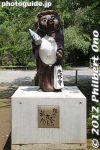
3. The large eyes is for seeing the situation and making correct and considerate decisions...
|
|
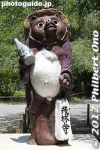
4. The large belly is for being calm as well as bold...
|
|
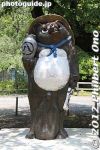
5. A sake flask in the left hand for innate virtue...
|
|
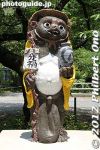
6. An unpaid bill in the left hand symbolizes trust...
|
|
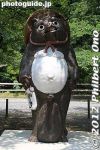
7. Large gonads between the legs which is the money bag for prosperity...
|
|
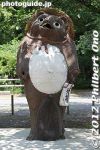
8. A thick tail for reliability and stability no matter what.
|
|

Tanuki raccoon dog statue at Morinji temple at Tatebayashi, Gunma Prefecture.
|
|
|
|
|
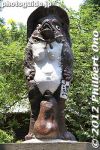
A giant Tanuki raccoon dog statue at Morinji temple at Tatebayashi, Gunma Prefecture. Donated by Tobu Railway in 1960.
|
|
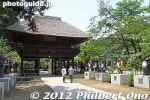
Sanmon Gate at Morinji temple. 山門
|
|
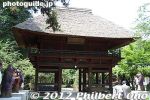
Sanmon Gate at Morinji temple. The Sanmon Gate is usually called the Akamon Gate 山門(通称赤門). The largest and most distinguished-looking gate.
|
|
|
|
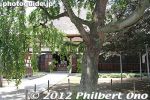
A large weeping cherry tree hides the Hondo main hall.
|
|
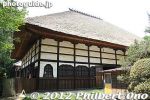
Morinji temple's Hondo main hall. 本堂
|
|
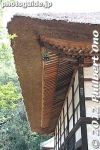
The Hondo Hall has a thatched-roof.
|
|
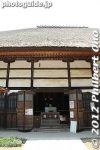
Morinji temple's Hondo main hall. 本堂
|
|
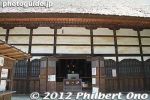
Morinji temple's Hondo main hall was originally built in 1468 and repaired in 1727. 本堂
|
|
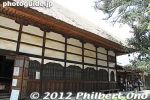
Morinji temple's Hondo main hall can be entered through the reception window on the right. 300 yen admission charged (150 yen for kids). Open 9 am-4 pm. Closed Thu.
|
|
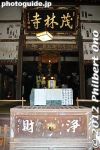
Morinji temple's offertory box and altar inside.
|
|
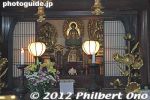
Morinji temple's Buddhist altar inside the Hondo Hall. The Shakanyorai (釈迦如来) or Gautama Buddha is worshipped. 本堂
|
|
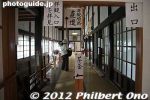
Pay a small admission fee to enter the Hondo from the right side. You can walk around inside the Hondo hall and see the altars.
|
|
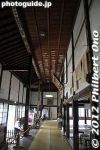
Inside Hondo hall.
|
|
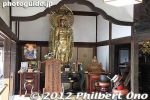
A side altar inside the Hondo hall.
|
|
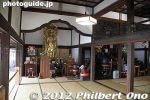
Morinji's Hondo hall also has statues of the temple founder Chief Priest Dairin Shotsu-Osho (大林正通大和尚) and longtime assistant Priest Shukaku-Osho (守鶴和尚).
|
|
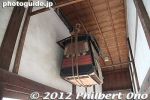
A palanquin exhibited near the ceiling.
|
|

Then there's a showroom of many tanuki sculptures, both wooden and stuffed.
|
|
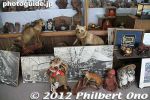
Tanuki sculptures
|
|
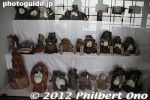
Tanuki statues in the showcase looked very old.
|
|
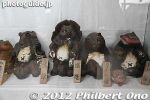
Old Tanuki statues at Morinji temple,
|
|
|
|